AMD and Intel Mobile Rematch: Gateway NV5933u vs. Acer 5542
by Jarred Walton on June 18, 2010 1:14 AM ESTGeneral Application Performance Compared
With the general overview of the two laptops out of the way, it's time to look at performance numbers. Starting with our general application benchmarks, we expect the i3-330M to easily win in these tests, particularly if an application can leverage more than two CPU cores. The i3 line doesn't have the Turbo modes found on i5 processors, but you still get Hyper-Threading which is good for an extra 10-20% performance depending on the application.
[Note: We're still collecting the Toshiba A505 with M600 results; at this point, the A505 Futuremark results are preliminary scores, as we've only had a chance to run them once. We'll have the final results in the forthcoming review.]

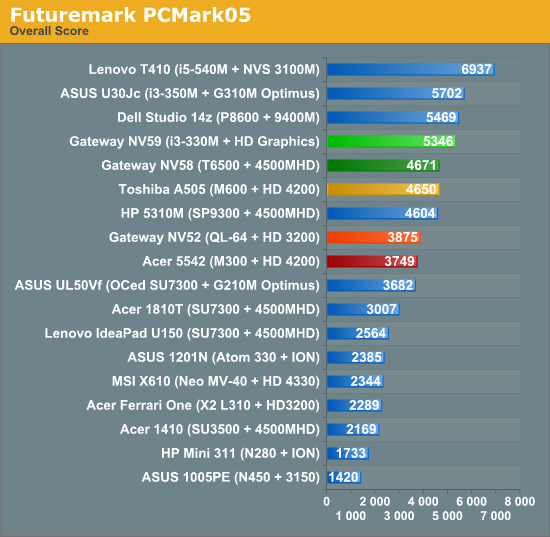
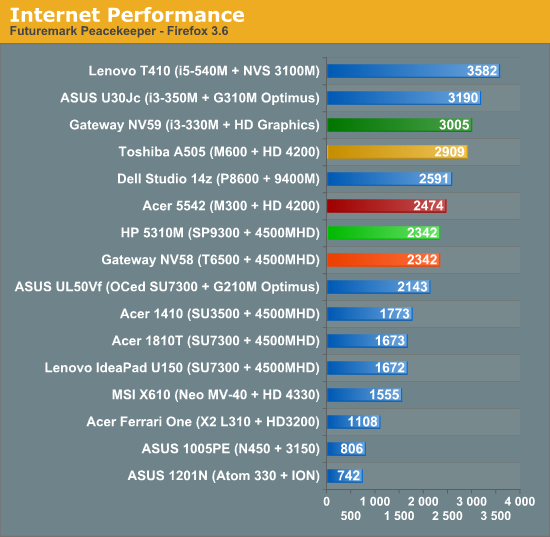
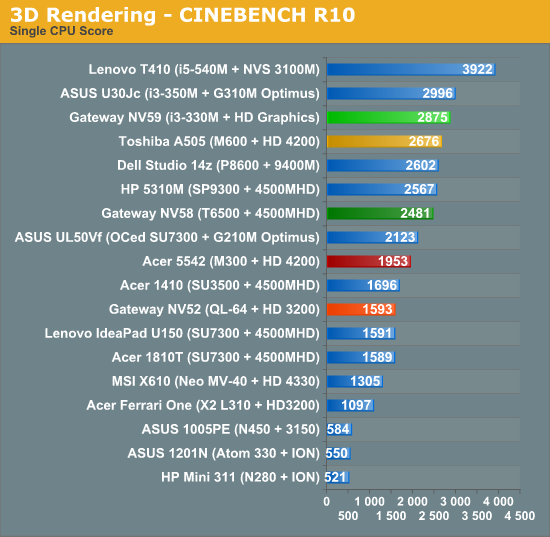
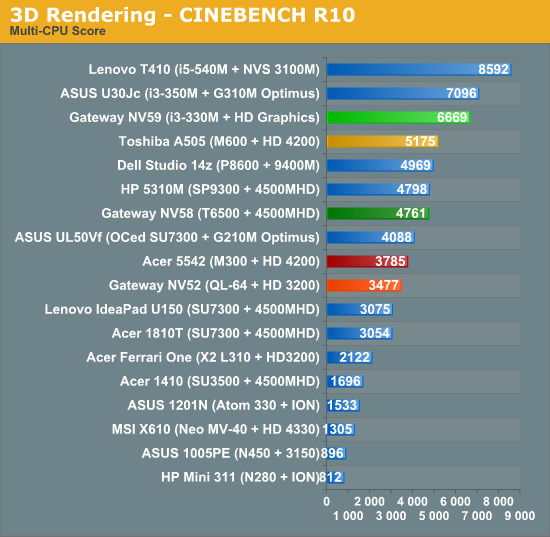
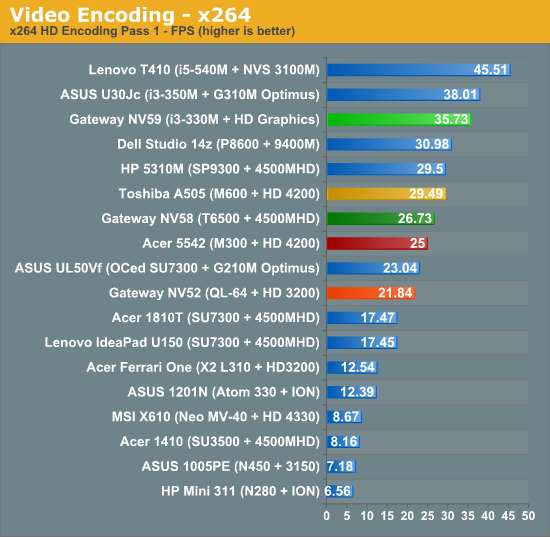

Let's start with PCMark, since it's a good representation of real world applications. PCMark puts the NV59 quite a bit ahead of the 5542, though with different hard drives there are other factors in play. The gap in Vantage is 52% while it's "only" 42% in 05, and in general use the NV59 certainly feels quite a bit faster. Results in the other application tests continue the trend of Intel leading in general performance. The closest score is in Peacekeeper, a single-threaded Internet benchmark, with the NV59 leading the 5542 by 21%. The x264 encoding advantage is 43% for pass one, and the second pass where multithreading really plays a role has the i3-330M leading by 73%. Cinebench is similar: 47% lead for i3-330M in single-threaded mode, and a 76% lead in the multi-threaded test.
It's no surprise that Intel is leading in CPU performance, as they've been ahead of AMD since Core 2 launched and Core i7/i5/i3 only increased that lead. That's not to say that the 5542 is slow, but the M300 isn't a very good competitor as far as general CPU performance is concerned. Clocked at 2.0GHz, architectural improvements make it slightly faster than the old QL-64, but chips like the M500 and M600 are much more competitive. We've included the Toshiba A5050 with a Turion II M600 for reference here, and it does much better. Of course Intel has plenty of faster CPUs as well—the i3-330M is their slowest i-Series processor. Anyway, as Atom has proven, if you're just surfing the Internet and running office applications any modern laptop is more than sufficient; these systems are substantially faster than netbooks and CULV laptops, so they're certainly in the category of "fast enough".
Also worth noting is the improvement in performance both platforms have shown relative to last year's models. We're using our Windows 7 results here, so the OS isn't a factor, and the basic entry-level AMD laptop is still 10-15% faster in many of the tests, even with a slightly lower clock speed. Clearly the change from an old K8-based architecture to the 45nm K10-based design helps, with PCMark05 being the only test where the 5542 didn't beat NV52. On the Intel side, the performance gap is much greater. The smallest gains are around 15% in single-core Cinebench and PCMark05. PCMark Vantage improves 33%, with Peacekeeper and x264 pass 1 around 30% as well. The biggest gains are in multi-threaded tests where Hyper-Threading is able to boost performance by up to 45% over the old T6500.
We also tested the latest release of Flash 10.1 with the latest drivers from both AMD and Intel. Unlike previous tests, all of our Flash video testing went off without a hitch—yes, even 1080p YouTube videos played in full screen mode without dropping frames. The NV5933u comes with a Blu-ray drive, and we also tested several Blu-ray movies, the most intensive being a 37Mbps AVC encode. There were no issues there either. But there's more to laptops than general performance, so let's look at a few other metrics.










38 Comments
View All Comments
silverblue - Friday, June 18, 2010 - link
...PLEASE stop using the 4200 unless you're going to offer an automatically switchable and far superior discrete option. Would it be outlandish to use the Mobility 5470 at the very least instead of throwing out the same 500-700MHz 40SP solutions?JarredWalton - Friday, June 18, 2010 - link
We should be seeing the Toshiba Satellite A665D-S6059 soon, which combines the HD 4250 with a discrete HD 5650 and provides switching functionality. It also has the Phenom II P920 quad-core (only 1.6GHz though). I'm certainly interested in seeing how it works, and hopefully GPU driver updates won't be a problem... except it looks like Toshiba is opting out of AMD's Mobile Driver program. Ugh.ferro_i - Friday, June 18, 2010 - link
AMD processor, the previous platform. (Tigris platform 2009, DDR2).İntel Mobile i3-i5 series should be compared with platform AMD Danube (2010).
JarredWalton - Friday, June 18, 2010 - link
I think it's fair in that we're comparing laptops that have both been around for four months. But you're right, Danube is the real comparison now and we're working to get some appropriate laptops. I inadvertently lumped all the new AMD laptops under the Nile header, but that's the ultraportable version of Danube; we should have both in the next couple of weeks.veri745 - Sunday, June 20, 2010 - link
Agreed. We already know the DDR2 AMD platforms have crappy battery life. I'd really like to see the Danube and Nile platforms reviewed.fabarati - Friday, June 18, 2010 - link
Good thing to note: Core i5s and i7s have a higher clocked IGP, 766 vs 677 in the i3s. Performance probably won't go up a lot, but maybe a fps or two.By the way, are you guys gonna review the Dell Vostro 3500?
JarredWalton - Friday, June 18, 2010 - link
We can ask for the Vostro 3500... no idea if we'll get one. As for the GPU clock, that's a good point. Is there a good utility to show your current clock? I have no idea if the NV5933u every scaled up to 667 or not; GPUZ and CPUZ don't report the IGP frequency on Intel.KaarlisK - Sunday, June 20, 2010 - link
Not always, it won'tSince the IGP has to Turbo up to get to either 677 or 766, and the i5s and i7s have higher CPU frequencies, there is sometimes less power/heat headroom for the GPU to actually clock up.
mojtabaalemi - Friday, June 18, 2010 - link
could you please add 1005p in your battery life test .and by the way was 1005pe with 3150 igp capable of 720p x264 video ?
JarredWalton - Friday, June 18, 2010 - link
We never had the 1005p for testing (or any other 3-cell netbook), so I'm not sure what it does for battery life other than it would be lower. :-) Relative battery life should be about the same, though, so at 23Wh it should last roughly half as long as the 1001p.The 1005pe (and any other Pine Trail netbook as well as the older N270/N280) is capable of 720p x264 if you use the CoreAVC codec; anything else and you drop frames in my experience. Higher bitrate 720p would also cause problems, and you get tearing (no VSYNC) with CoreAVC in my experience. As far as Internet video (Flash... not sure about the HTML5 stuff yet), Atom fails utterly unless you get ION/NG-ION.